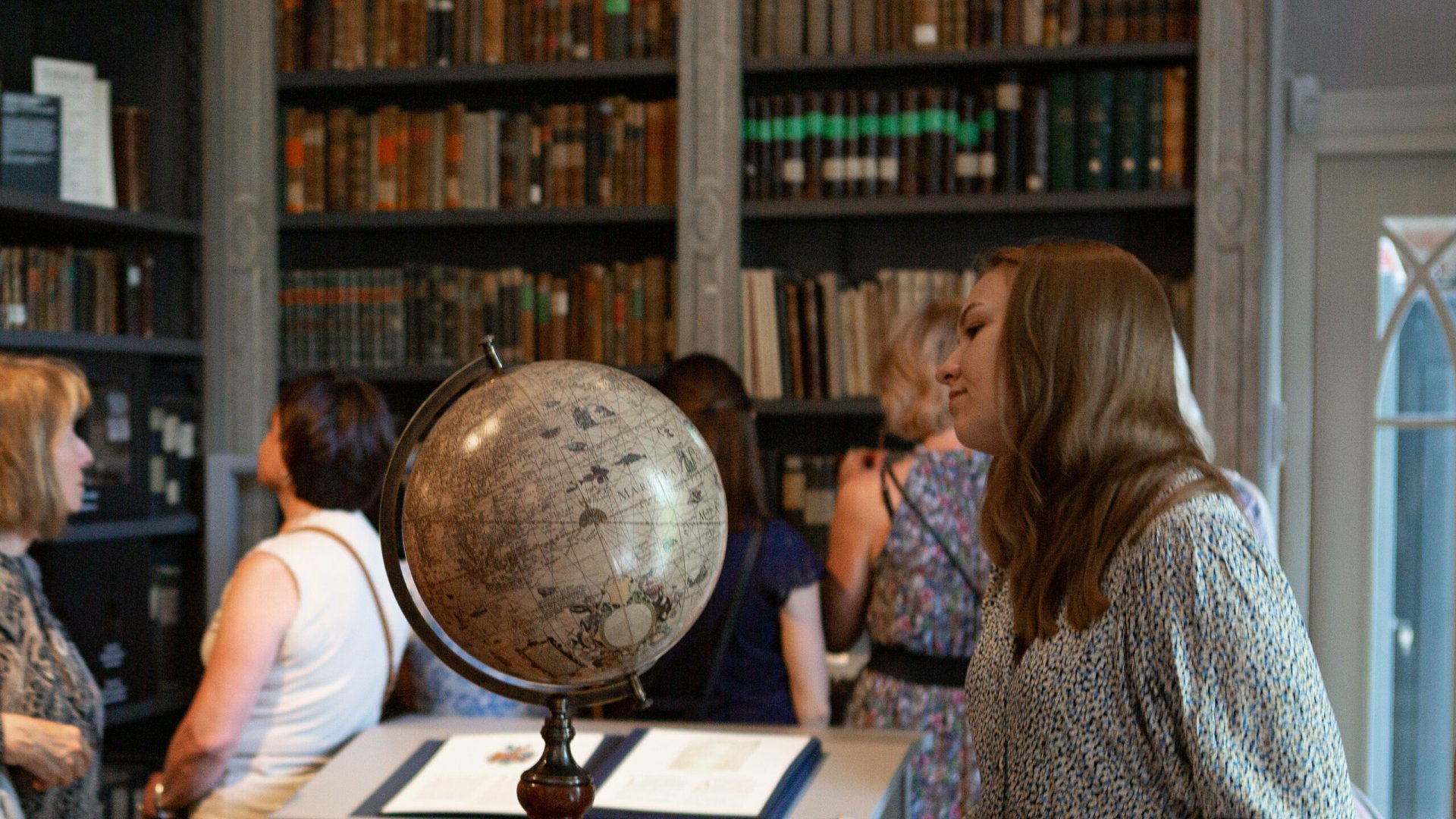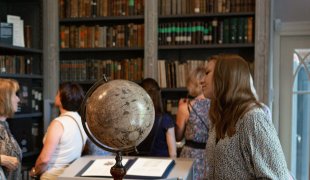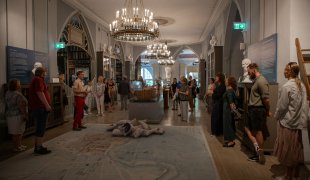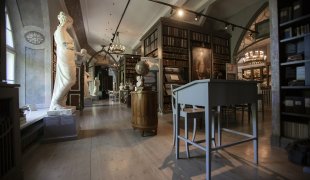Permanent exhibition of the history of the University of Tartu “The University of Our Lives”
The permanent exhibition that has opened in honour of the Estonian national university’s 100th birthday looks into the University of Tartu’s influence in our lives.
The university’s alumni, citizens of Tartu and foreign guests can all get nostalgic while exploring the historical library hall. The exhibition has exciting places for children too.
What is the spirit of the university?
Is it the wisdom of professors, colourful student life, or sad loneliness and endless love?
The spirit of Universitas affects both the world of science and our everyday lives more than we may realise. It can be argued that without the university there would be no Estonians and no Estonia. Life would also be different from how it is today and how we imagine it tomorrow.
The exhibition “The University of Our Lives” tells the stories of all 180,000 students of the University of Tartu. This is an exhibition of eternal youth, discoveries, choices and upheavals.
“All in all, it does not matter how many and which exams you passed, but the fact that you lived these five years with such people and in such an environment called the University of Tartu is what matters. It is much more important than grades”.
Activities for everyone
The exhibition has both textual and interactive exhibits that tell the story of the University of Tartu. For example, you can test your knowledge on student organisations, spin the wheel of historical facts, and try to calculate with mechanical multiplication rods, just as it was done in the 17th century
You can watch videos where well-known alumni and researchers share vivid memories of their alma mater. You can also explore detailed models of former student rooms. A 15-minute fun animation at the beginning of the exhibition gives a brief overview of the university’s history.
You can search for information about yourself, your relatives or acquaintances in the Album Academicum database, a collection of alumni of the University of Tartu.
There is a special secret library for children, with well-loved children’s books instead of academic ones.
And you can pick up a book from a shelf and spend a leisurely hour or two reading.
The historical library
The exhibition hall houses the partially preserved library, which operated in the cathedral for over 175 years. The interior design uses old furniture preserved for the purpose of the exhibition, and new furniture created by interior designer Mari Kurismaa that is based on the old.
Accessibility
Getting there
- The exhibition is on the fifth floor of the museum, accessible by elevator.
- There is a high threshold at the door of the hall, and staff can provide a wooden ramp to help cross it.
Seating
- The exhibition hall has plenty of chairs with backs that can be moved around the room freely.
- The hall has several benches without backs and a hanging sofa. You can also sit on the windowsills.
Light and sound
- The lightning in the room is dimmed to protect the historical objects.
- Important objects and texts are illuminated with spot lights.
- The hall is large and the following sounds can be regularly heard: whispers of “alma mater” and “Das ist meine Bibliothek”, footsteps on the Angel’s Bridge, a quiet cough.
- You can listen to the videos in the introductory part of the exhibition with headphones or, if preferred, loudspeakers; staff can help visitors switch the sound between the two as required.
- Several models of 20th-century student rooms as well as the door of the Zavood bar have background sounds that can be activated by pressing a button or moving the door.
Read about the accessibility of the entire building here.
Project team
Curators: Ken Ird, Karoliina Kalda, Kaija-Liisa Koovit, Janet Laidla, Virge Lell, Lea Leppik, Külli Lupkin, Terje Lõbu, Paula Põder, Kristiina Tiideberg
Head curator: Mariann Raisma
Project manager: Karoliina Kalda
Interior designer: Mari Kurismaa
Graphic designer: Mari Kaljuste
Graphic material: Maarja Roosi (University of Tartu Press)
Language editors: Katrin Kern, Hille Saluäär, Reet Vääri
Translators: Kristopher Rikken, Scriba, Juta Ristsoo, Katiliina Gielen, Sirje Kupp-Sazonov, Kaspar Kolk
English language editor: Daniel Edward Allen
Preservation consultants: Kristiina Ribelus, Tiina Vint, Maria Väinsar
Conservators: Anne Arus, Kristiina Ribelus, Maria Väinsar, Indrek Ikkonen (Estonian National Museum), Karl-Erik Hiiemaa (Estonian National Museum), Mariliis Vaks (Estonian National Museum)
Collection managers: Jaanika Anderson, Virge Lell, Ingrid Sahk, Maris Tuuling, Aile Tammiste
Educational programmes: Tiiu Kreegipuu
Interactive exhibits: Exporabbit
Models of student rooms: Sheip, Clownplay
Programmes: Vatson, Exporabbit, Avar Agentuur
Animation of the University of Tartu: Mart Kivastik, Paula Mauer, Robert Annus, Ardo Ran Varres
Movies: Plankfilm
Technical equipment: Hansab
Furniture restoration: Babach, Räsa, Martin Tamm
Exhibition furniture: Riksen, Wako Wärkstuba
Installation: Piret Hirv, Kristiina Laurits, Eve Margus-Villems
Craftsmen: Tanel Nõmmik, Marko Nõmmik
Maps: Maa-amet, Tiit Kaljuste
Framing: Joonstuudio, Raamimees, Raamikoda
Printing and mounting: Salibar, Laserstuudio, University of Tartu Press, Valge Kass, Reklaamitsehh
Copies of the constituent act: Lilian Bristol, Tatiana Iakovleva, Pille Kivihall
Plaster copies: Karin Kivisild, Maarit Mälgi, Maria Väinsar (Pallas University of Applied Sciences)
Books: University of Tartu Museum, Tartu Public Library, Hoiuraamatukogu, University of Tartu Library, private collections
Carpet: Lincona
Construction project managers: Arvo Avi, Raimo Talts (University of Tartu)
Construction: PVH Ehitus
Weak current: G4S
Electricity: Koduelekter, Alter
Floor treatment: Teket
The renovation of the hall and creation of the exhibition were funded by the University of Tartu, the Ministry of Culture, Epp Tsirk-Jüriado via the Estonian American Fund, Cultural Endowment of Estonia, the city of Tartu, Embassy of Sweden, Moodne Valgustus and Joonstuudio.
The exhibition has received the Cultural Endowment of Estonia’s folk culture endowment award.




